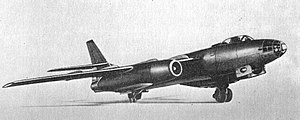Ilyushin Il-30
| Il-30 | |
|---|---|
 |
|
| Three-quarter view of the Il-30 | |
| Role | Bomber |
| National origin | Soviet Union |
| Manufacturer | Ilyushin |
| First flight | Unknown |
| Number built | 1 |
| Developed from | Ilyushin Il-28 |
The Ilyushin Il-30 was a Soviet turbojet-powered tactical bomber designed as a higher-performance, swept wing version of the Ilyushin Il-28 in the late 1940s. Its thin wing and engine nacelles necessitated the use of tandem landing gear, the first Soviet aircraft to do so. It was apparently canceled before the prototype made its first flight, although sources disagree on this.
The Il-30 was a follow-on to the Il-28, although design began on 21 June 1948, before the Il-28 had flown. It was designed to meet a requirement for a jet bomber that could carry 2,000 kg (4,400 lb) to a range of 3,500 km (2,200 mi) with a maximum speed no less than 1,000 km/h (620 mph). The design took that of the Il-28 as a starting point, but had thin, mid-mounted swept wings with a 35° sweep angle chosen to allow the aircraft to reach its required speed. It was intended to be powered by two new Lyulka TR-3 axial-flow turbojet engines with 45.1 kN (10,140 lbf) thrust each in wing-mounted nacelles. Both the fuselage and the nacelles were area ruled.
The thin wing and the 2° anhedral necessary to cure the excessive lateral stability limited the amount of fuel that could be carried and tip tanks were required to meet the range requirement. The slim engine nacelles did not allow the main landing gear to be stowed there as was done in the Il-28. The solution was to house them within the fuselage — the first bicycle landing gear on a Soviet aircraft — with small, twin-wheeled, outriggers mounted underneath the nacelles to stabilize the aircraft on the ground. The aircraft had a crew of four, the pilot, a bombardier, and two gunners. The pilot, bombardier and the dorsal gunner shared one pressurized compartment that was subdivided into the cockpit and the bombardier's position in the extensively glazed nose. The dorsal gunner was placed back-to-back with the pilot underneath the canopy and the tail gunner had his own separate pressurized compartment at the rear of the aircraft. Defensive armament was six 23 mm (0.91 in) Nudelman-Rikhter NR-23 cannon, two fixed forward and one pair each in the Il-V-12 dorsal turret immediately behind the cockpit and the Il-K6 tail turret. Maximum bomb load was 4,000 kg (8,800 lb)
...
Wikipedia
